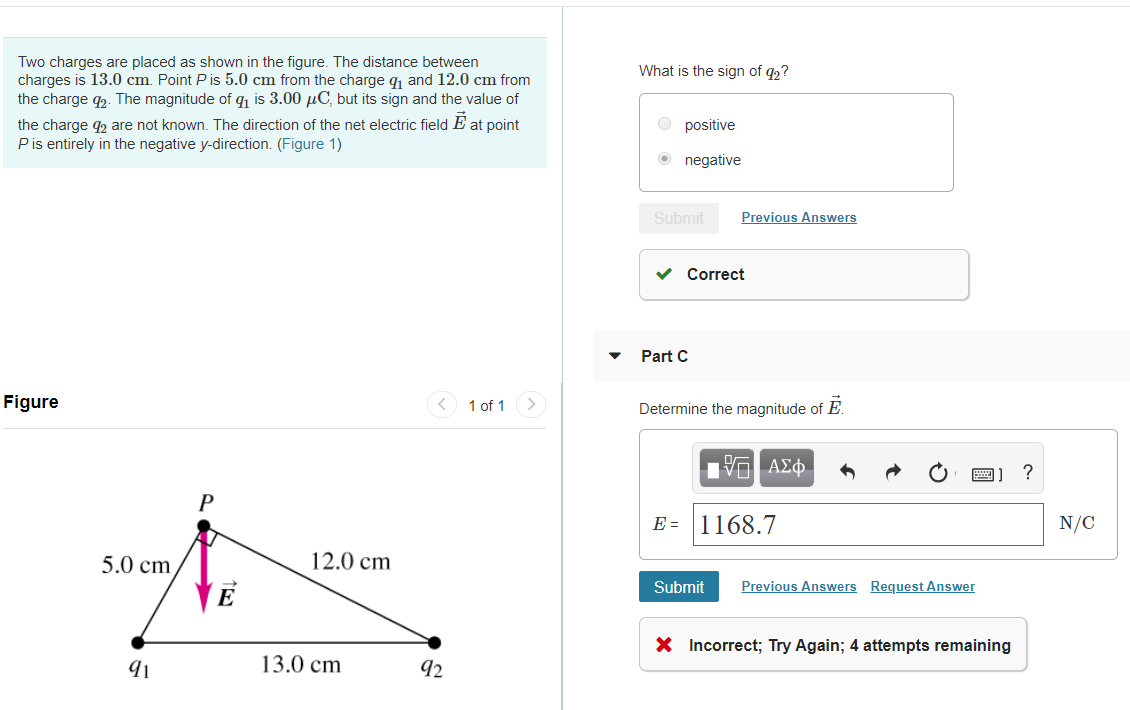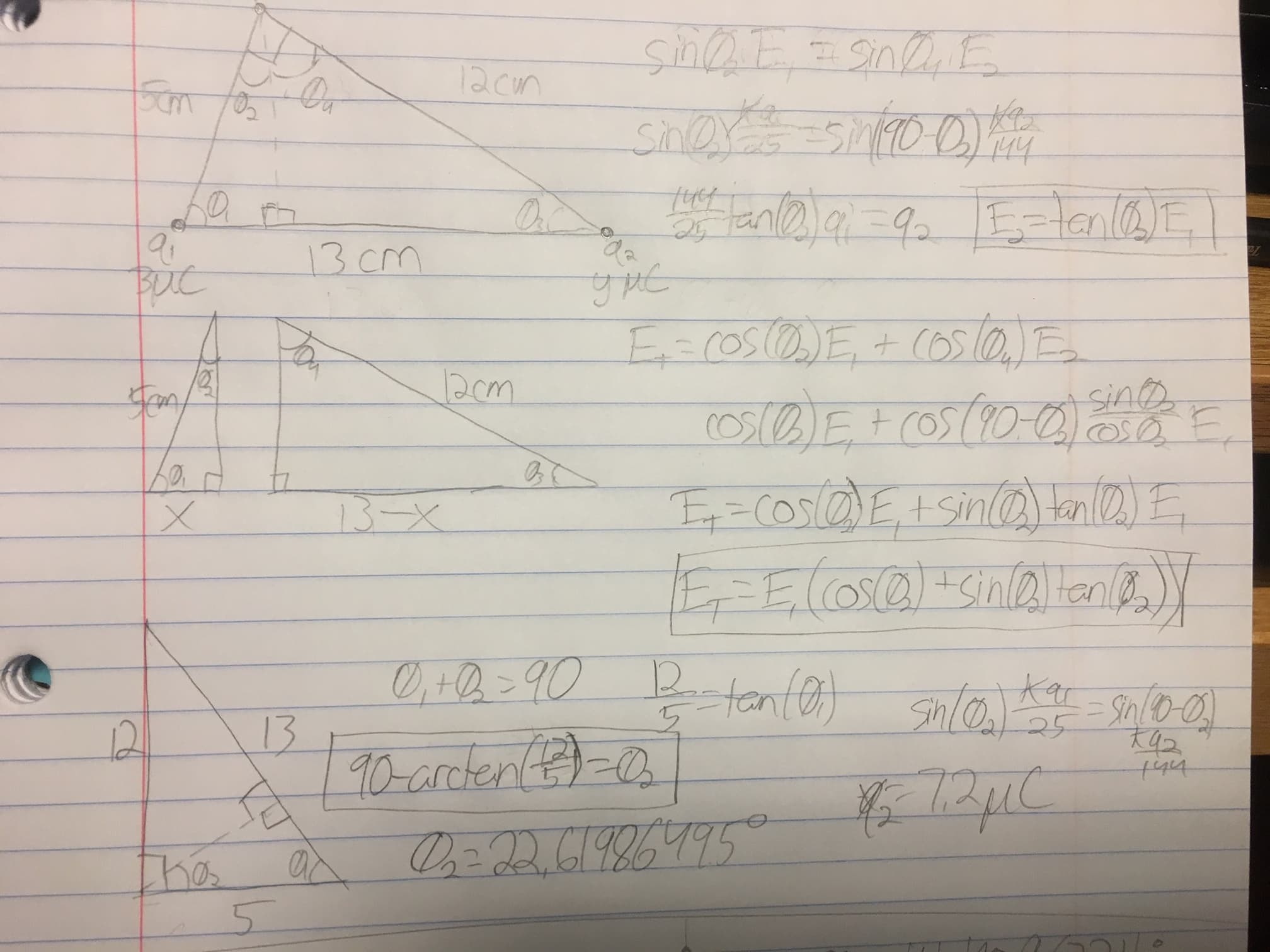Two charges are placed as shown in the figure. The distance between charges is 13.0 cm Point P is 5.0 cm from the charge q1 and 12.0 cm from the charge g2. The magnitude of q is 3.00 pC, but its sign and the value of the charge g2 are not known. The direction of the net electric field E at point P is entirely in the negative y-direction. (Figure 1) What is the sign of q2? positive negative Previous Answers Submit Correct Part C Figure 1 of 1 Determine the magnitude of E. VOA¢ P E 1168.7 N/C 12.0 cm 5.0 cm Previous Answers Request Answer Submit XIncorrect; Try Again; 4 attempts remaining 13.0 cm 92 13 cm gne + om sine + E(ostoE Sin@o2)E EEE(oESnAlat 3X + C+D=9O 13 10earcdenE Honfy २२५
Two charges are placed as shown in the figure. The distance between charges is 13.0 cm Point P is 5.0 cm from the charge q1 and 12.0 cm from the charge g2. The magnitude of q is 3.00 pC, but its sign and the value of the charge g2 are not known. The direction of the net electric field E at point P is entirely in the negative y-direction. (Figure 1) What is the sign of q2? positive negative Previous Answers Submit Correct Part C Figure 1 of 1 Determine the magnitude of E. VOA¢ P E 1168.7 N/C 12.0 cm 5.0 cm Previous Answers Request Answer Submit XIncorrect; Try Again; 4 attempts remaining 13.0 cm 92 13 cm gne + om sine + E(ostoE Sin@o2)E EEE(oESnAlat 3X + C+D=9O 13 10earcdenE Honfy २२५
Physics for Scientists and Engineers: Foundations and Connections
1st Edition
ISBN:9781133939146
Author:Katz, Debora M.
Publisher:Katz, Debora M.
Chapter23: Electric Forces
Section: Chapter Questions
Problem 29PQ: Two particles with charges q1 and q2 are separated by a distance d, and each exerts an electric...
Related questions
Question
100%
My problem is related to electric fields, as the picture shows. I tried decomposing each of the forces of the charges, setting the horizontal components equal, solving for q2, and then adding the vertical components.

Transcribed Image Text:Two charges are placed as shown in the figure. The distance between
charges is 13.0 cm Point P is 5.0 cm from the charge q1 and 12.0 cm from
the charge g2. The magnitude of q is 3.00 pC, but its sign and the value of
the charge g2 are not known. The direction of the net electric field E at point
P is entirely in the negative y-direction. (Figure 1)
What is the sign of q2?
positive
negative
Previous Answers
Submit
Correct
Part C
Figure
1 of 1
Determine the magnitude of E.
VOA¢
P
E 1168.7
N/C
12.0 cm
5.0 cm
Previous Answers
Request Answer
Submit
XIncorrect; Try Again; 4 attempts remaining
13.0 cm
92

Transcribed Image Text:13 cm
gne
+
om
sine
+
E(ostoE Sin@o2)E
EEE(oESnAlat
3X
+
C+D=9O
13
10earcdenE
Honfy
२२५
Expert Solution
Trending now
This is a popular solution!
Step by step
Solved in 10 steps with 10 images

Knowledge Booster
Learn more about
Need a deep-dive on the concept behind this application? Look no further. Learn more about this topic, physics and related others by exploring similar questions and additional content below.Recommended textbooks for you

Physics for Scientists and Engineers: Foundations…
Physics
ISBN:
9781133939146
Author:
Katz, Debora M.
Publisher:
Cengage Learning

College Physics
Physics
ISBN:
9781305952300
Author:
Raymond A. Serway, Chris Vuille
Publisher:
Cengage Learning

College Physics
Physics
ISBN:
9781285737027
Author:
Raymond A. Serway, Chris Vuille
Publisher:
Cengage Learning

Physics for Scientists and Engineers: Foundations…
Physics
ISBN:
9781133939146
Author:
Katz, Debora M.
Publisher:
Cengage Learning

College Physics
Physics
ISBN:
9781305952300
Author:
Raymond A. Serway, Chris Vuille
Publisher:
Cengage Learning

College Physics
Physics
ISBN:
9781285737027
Author:
Raymond A. Serway, Chris Vuille
Publisher:
Cengage Learning

Principles of Physics: A Calculus-Based Text
Physics
ISBN:
9781133104261
Author:
Raymond A. Serway, John W. Jewett
Publisher:
Cengage Learning


Physics for Scientists and Engineers with Modern …
Physics
ISBN:
9781337553292
Author:
Raymond A. Serway, John W. Jewett
Publisher:
Cengage Learning